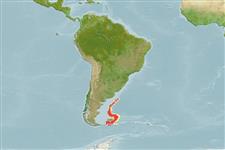Classification / Names
Common names from other countries
Main reference
Size / Weight / Age
Max length : 80.0 cm TL male/unsexed; (Ref. 1371)
Environment
Marine; bathydemersal; depth range 300 - 1400 m
Climate / Range
Deep-water, preferred 9°C (Ref. 107945); 39°S - 57°S, 62°W - 38°W (Ref. 1371)
Distribution
Southwest Atlantic: so far known only from the Patagonian slope from east of the Rio de la Plata to north of the Falkland Islands and off Shag Rock west of South Georgia. It can be expected also on the west coast of Chile, but its presence there, as well as in other regions where it has been reported must be confirmed.
Countries | FAO areas | Ecosystems | Occurrences | Introductions
Short description
IUCN Red List Status (Ref. 115185)
Threat to humans
Harmless
Human uses
Fisheries: minor commercial
More information
Common namesSynonymsMetabolismPredatorsEcotoxicologyReproductionMaturitySpawningFecundityEggsEgg development
Age/SizeGrowthLength-weightLength-lengthLength-frequenciesMorphometricsMorphologyLarvaeLarval dynamicsRecruitmentAbundance
Tools
Special reports
Download XML
Internet sources
Estimates of some properties based on models
Phylogenetic diversity index
PD50 = 0.5312 many relatives (e.g. carps) 0.5 - 2.0 few relatives (e.g. lungfishes)
Trophic Level
3.7 ±0.64 se; Based on food items.
Resilience
Very Low, minimum population doubling time more than 14 years (Preliminary K or Fecundity.)
Vulnerability
High vulnerability (63 of 100)
Price category
